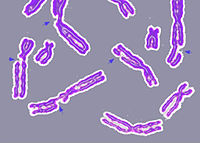
DNA Polymerase Delta Synthesizes Both Strands during Break-Induced Replication.
Sign Up to like & getrecommendations! Published in 2019 at "Molecular cell"
DOI: 10.1016/j.molcel.2019.07.033
Abstract: Break-induced replication (BIR) is a pathway of homology-directed repair that repairs one-ended DNA breaks, such as those formed at broken replication forks or uncapped telomeres. In contrast to conventional S phase DNA synthesis, BIR proceeds… read more here.
Keywords: dna; dna polymerase; break induced; replication ... See more keywords

Break-induced replication promotes formation of lethal joint molecules dissolved by Srs2
Sign Up to like & getrecommendations! Published in 2017 at "Nature Communications"
DOI: 10.1038/s41467-017-01987-2
Abstract: Break-induced replication (BIR) is a DNA double-strand break repair pathway that leads to genomic instabilities similar to those observed in cancer. BIR proceeds by a migrating bubble where asynchrony between leading and lagging strand synthesis… read more here.
Keywords: promotes formation; joint molecules; break induced; break ... See more keywords

Cell wall protein variation, break‐induced replication, and subtelomere dynamics in Candida glabrata
Sign Up to like & getrecommendations! Published in 2021 at "Molecular Microbiology"
DOI: 10.1111/mmi.14707
Abstract: Candida glabrata is an opportunistic pathogen of humans, responsible for up to 30% of disseminated candidiasis. Adherence of C. glabrata to host cells is mediated by adhesin‐like proteins (ALPs), about half of which are encoded… read more here.
Keywords: variation; break induced; candida glabrata; induced replication ... See more keywords

Repair of DNA Breaks by Break-Induced Replication.
Sign Up to like & getrecommendations! Published in 2021 at "Annual review of biochemistry"
DOI: 10.1146/annurev-biochem-081420-095551
Abstract: Double-strand DNA breaks (DSBs) are the most lethal type of DNA damage, making DSB repair critical for cell survival. However, some DSB repair pathways are mutagenic and promote genome rearrangements, leading to genome destabilization. One… read more here.
Keywords: biochemistry; dna breaks; break induced; repair ... See more keywords

CEP131 Abrogates CHK1 Inhibitor-Induced Replication Defects and Is Associated with Unfavorable Outcome in Neuroblastoma
Sign Up to like & getrecommendations! Published in 2020 at "Journal of Oncology"
DOI: 10.1155/2020/2752417
Abstract: Checkpoint kinase 1 (CHK1) plays a key role in genome surveillance and integrity throughout the cell cycle. Selective inhibitors of CHK1 (CHK1i) are undergoing clinical evaluation for various human malignancies, including neuroblastoma. Recently, we reported… read more here.
Keywords: chk1i; cep131; neuroblastoma; replication defects ... See more keywords

Suppressors of Break-Induced Replication in Human Cells
Sign Up to like & getrecommendations! Published in 2023 at "Genes"
DOI: 10.3390/genes14020398
Abstract: Short tandem DNA repeats are drivers of genome instability. To identify suppressors of break-induced mutagenesis human cells, unbiased genetic screens were conducted using a lentiviral shRNA library. The recipient cells possessed fragile non-B DNA that… read more here.
Keywords: break induced; dna; suppressors break; human cells ... See more keywords

PRIMPOL competes with RAD51 to resolve G-quadruplex-induced replication stress via its interaction with RPA
Sign Up to like & getrecommendations! Published in 2022 at "Acta Biochimica et Biophysica Sinica"
DOI: 10.3724/abbs.2022165
Abstract: PRIMPOL (primase-polymerase) is a recently discovered DNA primase-polymerase involved in DNA damage tolerance and replication stress response in eukaryotic cells. However, the detailed mechanism of the PRIMPOL response to replication stress remains elusive. Here, we… read more here.
Keywords: primpol competes; replication; replication stress; induced replication ... See more keywords